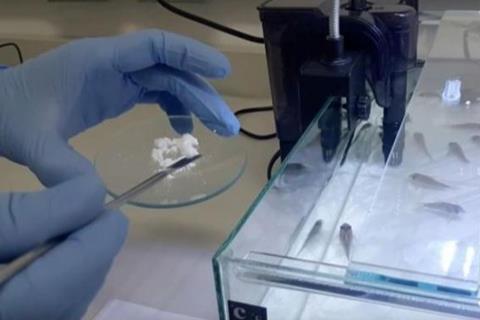A novel biomaterial developed at the Federal University of São Paulo (UNIFESP) in Brazil can help solve two problems at once.
As a bioparticle, it can act as a drug carrier, delivering medication directly to the gastrointestinal tract of fish in order to circumvent resistance to conventional antibiotics, for example.

In addition, it is administered orally in powder form and is highly palatable to fish, increasing the probability of effective treatment while at the same time reducing the waste and pollution inherent in the medication of these animals.
The research is reported in an article published in the journal Biomaterials Advances.
Straight to the intestine
“Our bioparticle can pass through the digestive tract and deliver medication directly to the intestine, enhancing the efficacy of conventional drugs, which is increasingly impaired by bacterial resistance,” said Patrick D. Mathews, a co-author of the article. The research was conducted while he was a postdoctoral fellow at UNIFESP’s Medical School (EPM).
“The material can be administered directly in the water, where it is consumed by the fish. The normal delivery method entails mixing medication into feed, so you never know how much is actually consumed as opposed to just polluting the water. This has become a serious issue for large fish farming ventures such as Chile’s salmon industry,” said Mathews, who was recently awarded a Young Investigator Grant by FAPESP and will continue the research at São Paulo State University’s Botucatu Institute of Biosciences (IBB-UNESP).
The bioparticle is based on chitosan and alginate, polysaccharides of natural origin used in industry and research. Chitosan is derived from the shells of crustaceans, and alginate is derived from seaweed. The formulation also contains arginine, an amino acid present in most protein-rich foods. The antimicrobial molecule used was a peptide obtained from an arachnid found in Brazil’s Southeast region.
Catfish treatment
Specimens of Schwartz’s catfish (Corydoras schwartzi), an ornamental fish species native to the Amazon and other parts of South America, were treated with the biomaterial for eight days. Analysis of their intestinal tissue showed high penetration of the biomaterial into epithelial cells and deeper layers of the organ. Various histological methods failed to detect any cytotoxic effects or other damage due to the particle. Hematological tests confirmed the absence of toxicity in blood cells.
“We used materials known to have little or no cytotoxicity. Chitosan also has the advantage of adhering well to mucous membranes, as demonstrated in the study. The tests also showed that it tolerates digestive tract acidity and reaches the intestine intact,” said Omar Mertins, a professor in EPM-UNIFESP’s Biophysics Department and last author of the article.
The material resulted from two projects led by Mertins: “Improvement of the properties of the polysaccharide chitosan for its application in liposomes and giant vesicles” and “Crystalline-phase nano cubosome functionalized with biopolymers: development as a drug carrier and in vivo studies in zebrafish (Danio rerio)”.
Targeting parasites
In a previous study, the researchers tested the efficacy of a similar formulation against parasites that infect the same fish species. The bioparticle delivered the anthelmintic drug praziquantel, widely used to treat diseases caused by parasitic flatworms (helminths).
“These and other ornamental fish are mainly exported to Asia, Europe and the United States, taking large number of parasites with them. The introduction of novel pathogens via these exports is a significant risk for ecosystems and even commercial production, as they can contaminate both wild and farmed species,” Mathews said.
In the intestines of the animals colonized by worms, the bioparticle penetrated the cysts built by the parasites for self-protection, demonstrating that the material can be used as a drug carrier to treat other fish species. An application has been filed for a patent on one of the formulations.
Commercial farming
The researchers will now test this and other formulations to treat parasites in fish commercially farmed for human consumption, such as the Nile tilapia (Oreochromis niloticus) and the Tambaqui (Colossoma macropomum).
A study conducted in 2017 by another group of researchers estimated the annual loss to freshwater fish farming in Brazil due to disease at USD 84 million.
“The fact that the material is non-toxic to fish shows it isn’t harmful for humans who consume their flesh. The prospects for application are highly positive,” Mertins said.







No comments yet